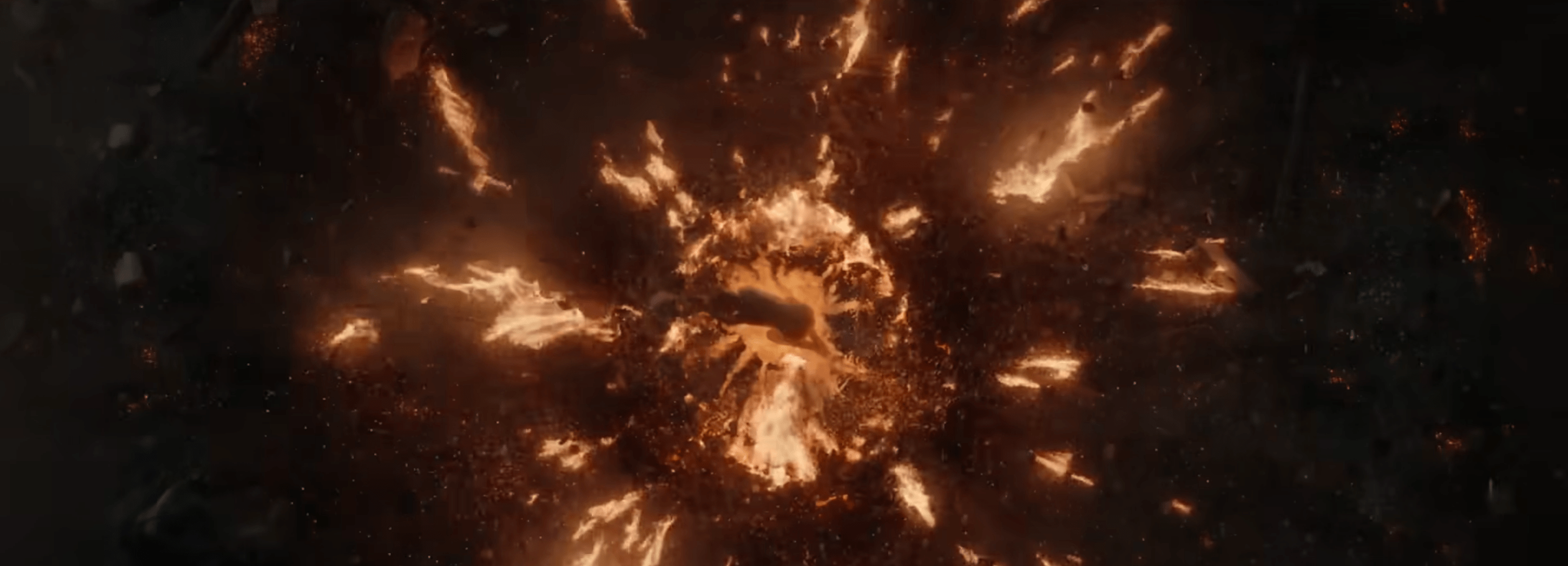
Ever since its announcement, The Lord of the Rings: The Rings of Power has been a subject of mass debate. It’s based on the appendices of Tolkien’s trilogy, as opposed to the trilogy itself, and set during the Second Age, an era for which we have a detailed chronology of historical events but far less knowledge of how said events transpired. And alongside well-loved characters like Elrond and Galadriel, it is introducing its own original players with Arondir, Bronwyn, and more.
One can parse the various strands of lore with the right Tolkien references, but there is one specific element of The Rings of Power that has left both scholars and sockpuppets reeling: the Stranger, or the wizard-like figure who crash-lands in Middle-earth via molten meteorite.
Viewers were first introduced to the Stranger (commonly referred to as Meteor Man) in the trailer for The Rings of Power season 1, during which several figures across Middle-earth could be seen watching a meteorite soar through the sky. Some people thought he was The Rings of Power’s Sauron, which was extremely incorrect. Others were and remain convinced that it’s Gandalf, but based on the context, it’s not that clear cut.
After watching what’s been released of The Rings of Power thus far, we’ve learned a little bit more about this mysterious figure — although this knowledge has only served to further our conviction that neither the Dark Lord nor Mithrandir is our guy. So, to assess who our magical friend could be, we first need to debunk who it almost certainly isn’t.
The Tolkien lore that might reveal the Stranger’s identity

One of the main reasons that people are convinced that this is either Gandalf or Sauron is because showrunners Patrick McKay and J.D. Payne all but confirmed it to be a figure of similar status in Vanity Fair’s 10 Burning Questions interview:
Well, I would say [Gandalf, Radagast, and Saruman] are not the only beings, those names, in that class. So maybe, but maybe not. And the mystery and the journey of it is all of the fun, I would say.
This is an interesting answer, because it points to the other “beings” and “names” of the class the wizards — known as Istari — share: They are all Maiar, meaning they’re sort of like angels. The Valar, who are above them, are closer to gods or celestial beings. To put it as plainly as possible, Meteor Man is probably a Maiar spirit, which is what both Gandalf and Sauron are. But so are the other Istari, including the mysterious Blue Wizards, as well as the Balrogs, among others. Meteor Man could therefore be one of many people — that’s not to mention the possibility he could also be a totally original character.
Why the Stranger could be Gandalf

In many ways, Gandalf seems like the obvious identity of this mysterious figure. He is found and helped by harfoots, which neatly aligns with his later affection for hobbits. The nature of his arrival via flaming meteorite is also apt, in that he is the Istar associated with fire. He is, quite obviously, a frail old man with long grey hair and an impressive beard — all features of the fana, or physical manifestation, of the Maiar who become Istari.
But the hobbit point is far too obvious a red herring. His affinity for fire is referenced several times in Tolkien’s writing (the most famous example being at the Bridge of Khazad-dûm where, after saying “You cannot pass!” he says, “I am the servant of the Secret Fire, wielder of the Flame of Anor!”), meaning he quite literally wields the fiery wrath of the sun.
But the biggest foil here is the timeline. Gandalf arrives in Middle-earth around the 10th century of the Third Age, which is approximately three millennia after the events we’re witnessing in The Rings of Power. Sure, time compression could be at play — and likely will be given the emphasis on Elrond’s recognition of 20 years as fleeting — but that’s a lot of time to breeze past. Also, the harfoots and Elves see the meteor at the same time, and are also geographically quite close to one another in that only the spine of the Misty Mountains separates Eregion from the Gladden River. All of which is to say: Gandalf receiving Narya, the Elven Ring of Fire, when he landed in Middle-earth is a crucial part not just of Tolkien’s legendarium, but of his identity as the Istar of Fire. That burning crater may be a clear visual reference to Gandalf, but in-universe it’s also too early in his timeline to have such a connection.
Also, let’s zoom in on Gandalf, the most humble of the Istari and the only one who ultimately succeeds in his mission, despite originally wanting to stay in Aman due to his fear of Sauron. You think this guy is making the most audacious entrance in the history of Middle-earth? Nah. He sails across, like the other Istari, and wanders around making friends with little hobbits. He doesn’t hurtle headlong through the sky in an actual meteorite. And in terms of the Stranger’s appearance as an old man… Lots of people are old. Middle-earth doesn’t function on the basis of “Old guy with a beard? Wizard confirmed.”
But the Stranger might be someone else entirely

With all of this being said, it makes sense for the Stranger to be a new character, of which we already have a few. Tolkien once said that the hobbits weren’t up to much during the Second Age, so the spotlighting of the harfoots is a good way to increase their significance alongside an original wizard (he is, of course, some sort of wizard or magical, what with the weird Stormcrow shouting that apparently affects the weather).
It’s also possible that he could be a conflation of the two Blue Wizards, who originally ventured to Middle-earth in the Third Age, but were later retconned into the Second Age by Tolkien himself. The Stranger’s nakedness and clear lapses in memory are aligned with this.
In the books, Gandalf speaks to his own nakedness preceding his resurrection as Gandalf the White, noting, “Darkness took me, and I strayed out of thought and time, and I wandered far on roads that I will not tell. Naked I was sent back — for a brief time, until my task is done.” Meanwhile, Tolkien wrote about Maiar having to get used to their corporeal bodies, which makes the sending of the two Blue Wizards — or an original character — fairly credible, in that it could have been a sort of prototype, experiment type of thing. This explains the Stranger’s memory loss, inability to speak, rapid fatigue, and awesome magical power in one fell swoop. It’s also a bit silly.
Personally, I am into the idea of it being Glorfindel, who dies fighting a Balrog in the First Age and is brought back as an emissary of the Valar in S.A. 1600. This is unlikely in that Meteor Man is, you know, a man, as opposed to a classically handsome elf. The main reason this would be cool is because Glorfindel was done dirty in Jackson’s trilogy, and absolutely deserves to be in The Rings of Power despite currently not being listed in the cast. But again, the Stranger’s appearance doesn’t exactly scream “elf who was allowed to live with gods before being sent back as an angelic emissary to cultivate lasting peace throughout the realm.” Disappointing.
The last possibility for who this could be if it isn’t an original character is Tilion, a minor Maiar spirit who controls the moon. There are two poems about him in Tolkien’s legendarium — one from The Adventures of Tom Bombadil, the other from The Fellowship of the Ring. These are called “The Man in the Moon Came Down Too Soon” and “The Man in the Moon Stayed Up Too Late,” and the former contains the following stanza:
He twinkled his feet, as he thought of the meat,
of pepper, and punch galore;
And he tripped unaware on his slanting stair,
and like a meteor,
A star in flight, ere Yule one night
flickering down he fell
From his laddery path to a foaming bath
in the windy Bay of Bel.
The meteor in this poem lands far away from our harfoot friends, and while the Stranger appears to be in a stupor, he is unlikely to have been overindulging in punch. It is, however, one of the only mentions of an actual meteor in Tolkien, and Tilion is a Maiar, making McKay and Payne’s status as lore experts and comments about the Maiar as a “class” interesting, at the very least. Again though, it’s unlikely to be Tilion — mostly because there is little reason to introduce him.
Sadly, we now know it’s not Tom Bombadil, but you can imagine how it could have been. Tom misunderstanding his own powers and accidentally summoning a meteor that carries him halfway across Middle-earth before crashing into the ground somewhere east of the Misty Mountains. Maybe he befriended the harfoots here and migrates west to The Shire alongside them. It would explain their absence from S.A. history, in that he could help them consciously stay out of it, while this overarching setup could potentially provide some fascinating backstory for why the One Ring has no control over Tom.
The Stranger is not Tom Bombadil. He’s probably Gandalf. But, oh, imagine the possibilities.
Source:https://www.polygon.com/23327884/rings-power-meteor-stranger-who-is-character-lord-rings-explained






